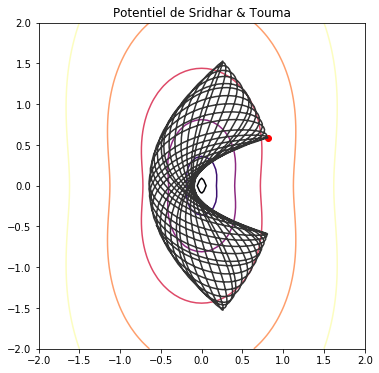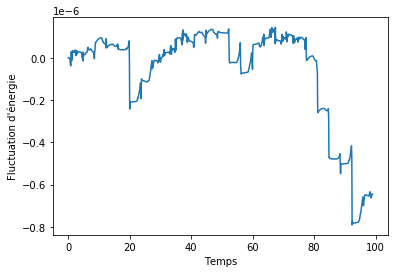Potentiel de Sridhar & Touma🔗
[1]:
import numpy as N
import matplotlib.pyplot as P
%matplotlib inline
Définition du potentiel et de ses dérivées🔗
Voir Sridhar & Touma (1999).
[2]:
def potentiel_ST(r, theta, alpha=0.5):
"""
Potentiel de Sridhar & Touma, coordonnées polaires (theta en radians).
"""
return r**alpha * ( (1 + N.cos(theta))**(1 + alpha) + (1 - N.cos(theta))**(1 + alpha) )
[3]:
def dpST_dr(r, theta, alpha=0.5):
"""
Dérivé du potientel ST par rapport à r.
"""
return alpha * potentiel_ST(r, theta, alpha=alpha) / r
[4]:
def dpST_dtheta(r, theta, alpha=0.5):
"""
Dérivé du potientel ST par rapport à theta.
"""
return - (1 + alpha) * N.sin(theta) * r**alpha * ( (1 + N.cos(theta))**alpha - (1 - N.cos(theta))**alpha )
Isopotentiels🔗
[5]:
def plot_isopotentiels(potentiel, x=None, y=None, ax=None):
"""
Trace les isopotentiels du *potentiel* (défini en coord. polaires).
"""
if ax is None:
fig, ax = P.subplots()
if x is None:
x = N.linspace(-2, 2, 61)
if y is None:
y = N.linspace(-2, 2, 61)
xx, yy = N.meshgrid(x, y)
# Conversion des coordonnées cartésiennes en polaires
r = N.hypot(xx, yy)
t = N.arctan2(yy, xx)
# Calcul du potentiel exprimés en coord. polaires
pot = potentiel(r, t)
ax.contour(xx, yy, pot)
return ax
[6]:
ax = plot_isopotentiels(potentiel_ST)
ax.set(title="Potentiel de Sridhar & Touma", aspect='equal')
ax.figure.set_size_inches((8, 6))

Intégration numérique des orbites🔗
[7]:
import scipy.integrate as SI
def zdot_ST(z, t):
"""
z = (r, theta, rdot, thetadot) pour le potentiel de ST(alpha=0.5).
"""
alpha = 0.5
r, theta, rdot, thetadot = z
rdotdot = r * thetadot**2 - dpST_dr(r, theta, alpha=alpha)
thetadotdot = -2/r * rdot * thetadot - r**-2 * dpST_dtheta(r, theta, alpha=alpha)
# zdot = (rdot, thetadot, rdotdot, thetadotdot)
return (rdot, thetadot, rdotdot, thetadotdot)
[8]:
def temps_caract(potentiel, r0, theta0):
"""
Temps caractéristique.
"""
return 2 * N.pi * r0 / potentiel(r0, theta0) ** 0.5
[9]:
def energie(zs, potentiel):
"""
Énergie totale = potentiel(r, theta) + 0.5 * (rp**2 + (r*thetap)**2)
"""
if N.ndim(zs) == 2:
rs, thetas, rdots, thetadots = zs.T
else:
rs, thetas, rdots, thetadots = zs
kin = 0.5 * (rdots**2 + (rs * thetadots)**2)
pot = potentiel(rs, thetas)
return kin + pot
Orbite sans vitesse initiale🔗
[10]:
r0, theta0, rdot0, thetadot0 = z0 = (1, N.pi/5, 0, 0) # Conditions initiales
tc = temps_caract(potentiel_ST, r0, theta0)
E0 = energie(z0, potentiel_ST)
print("Conditions initiales:", z0)
print("Temps caractéristique:", tc)
print("Énergie initiale:", E0)
Conditions initiales: (1, 0.6283185307179586, 0, 0)
Temps caractéristique: 3.96071923264
Énergie initiale: 2.51658510752
[11]:
ntc = 25 # Nb de temps caractéristiques
npts = 1000 # Nb de points
t = N.linspace(0, ntc * tc, npts)
zs = SI.odeint(zdot_ST, z0, t)
[12]:
rs, thetas, rdots, thetadots = zs.T
xs = rs * N.cos(thetas)
ys = rs * N.sin(thetas)
[13]:
ax = plot_isopotentiels(potentiel_ST)
ax.scatter([xs[0]], [ys[0]], marker='o', color='r') # Position initiale
ax.plot(xs, ys, color='0.2')
ax.set(title="Potentiel de Sridhar & Touma", aspect='equal')
ax.figure.set_size_inches((8, 6))

[14]:
es = energie(zs, potentiel_ST)
E0 = es[0]
fig, ax = P.subplots()
ax.plot(t, es/E0 - 1)
ax.set(xlabel='Temps', ylabel=u"Fluctuation d'énergie")
ax.ticklabel_format(style='sci', scilimits=(-3, 3), axis='y');

This page was generated from Projets/sridhar_touma.ipynb.
